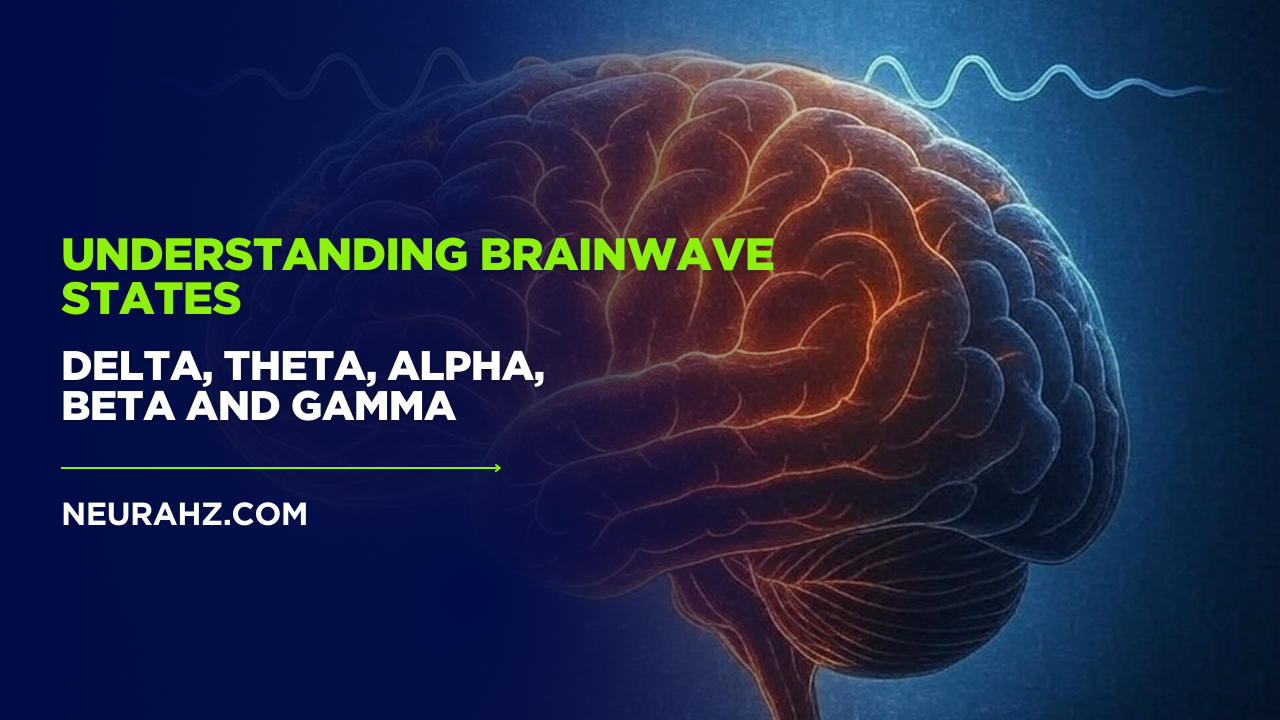Note: I’m mainly a researcher, not a professional writer, and English isn’t my first language. Please excuse any grammar mistakes or unpolished phrases you might find.
Understanding Brainwave States: Delta, Theta, Alpha, Beta, and Gamma
Our brains produce tiny electrical waves all the time, which you can measure with an EEG. These waves fall into five main bands: delta (0.5–4 Hz), theta (4–8 Hz), alpha (8–12 Hz), beta (12–35 Hz), and gamma (30+ Hz). Each band tends to show up during certain mental states. In simple terms, delta is the slow, deep-sleep wave, theta is a dreamy, relaxed wave, alpha is a calm awake state, beta is the busy, alert state, and gamma is the fast, information processing state. I dug into research to back this up, so here’s what I found about each wave and how sound might shift them.
Delta Waves
Delta waves are the slowest brainwaves (around 0.5 to 4 Hz), but their strength or amplitude is high. These usually show up when you’re in deep sleep without dreams or under heavy anesthesia. Scientists noticed that during deep non-REM sleep, the EEG shows these slow and strong delta waves very clearly. This deep state of sleep is important for recovery, both physical healing and memory processing happen more during this time.
Because delta equals deep sleep, some researchers have tried using sound to boost delta power. For example, a 2020 study took people’s own brain data from deep sleep (delta waves) and turned it into music. Then they had those same people listen to that sound before bed. The result? They fell asleep around 38% faster. This shows that when sound matches your natural brain rhythm, it can help the brain move into sleep more easily. (This study was published in Frontiers in Neuroscience. )
In other words, listening to music based on delta waves helped people fall asleep faster. This suggests external rhythms or binaural beats in the delta range might move the brain toward deeper sleep.
Theta Waves
Theta waves (about 4–8 Hz) come next. They often show up when you’re very relaxed, meditating, or daydreaming, or in the early stages of sleep. A classic description: You’re sitting on a train, looking out the window. Everything’s moving, but your mind isn’t really here. You don’t even realize how much time has passed, maybe 5 minutes, maybe 30. You’re not sleeping, but not fully awake either. Random thoughts come and go, like they have a mind of their own. You start thinking about things from the past, or something that never even happened. You didn’t choose to think about it, it just showed up. That’s what theta feels like. You’re not in control, but you’re not lost either. Just floating somewhere in between. You also see theta in creative moments.
Theta rhythms are prominent in the hippocampus, a brain area for memory and navigation, so some studies think theta helps form new memories or imaginative ideas.
In simple terms, theta is like being in a state between being awake and asleep, where your mind is wandering freely. It’s the state you hit when you’re super relaxed, or when you’re in light sleep. Some studies on meditation show that theta waves increase the deeper someone goes into their meditative state.
Sound Effects: Because theta is linked to relaxation and creativity, some try using binaural beats or music at ~6 Hz to induce it. There is some evidence that delta/theta beat stimulation can reduce anxiety. For instance, a study had anxious patients listen daily to delta/theta binaural beats for a month, and their anxiety scores significantly dropped. This suggests slow beats in the 1–7 Hz range can calm the nervous system. Of course, the science is mixed (some studies saw no change in focus or even small mood effects), but it seems plausible that gentle 5–7 Hz rhythms could help you relax or drift toward theta.
Alpha Waves
Alpha waves (around 8–12 Hz) are a middle ground band. You mostly see alpha when you’re awake but resting for example, sitting quietly with eyes closed or just chilling out. Hans Berger (who discovered EEG) found alpha as a dominant rhythm in relaxed wakefulness. When you relax after a task or enter a light meditative state, alpha tends to rise. It’s what you have when daydreaming or taking a break.
Alpha is like the brain’s “idling” mode. Research even shows that meditation increases alpha activity, especially in the back of the brain. In fact, closing your eyes or doing deep breathing can boost alpha power. Some studies find people with lots of alpha do better at tasks requiring relaxation and insight, though alpha’s full role is still studied.
Sound Effects: Many relaxing sound tracks claim to use alpha binaural beats (e.g. 10 Hz) to calm you. Some experiments have played alpha-range sounds during relaxation training and found it helps folks report more calmness, though the data is not bulletproof. One review noted that adding binaural beats (alpha or delta) to a relaxation protocol did change EEG connections suggesting your brain waves do respond to such rhythms. But as with all entrainment research, results vary. Still, if you put on a gentle 10 Hz beat to each ear, your brain may tend to sync up a bit, moving you toward a relaxed alpha state (binaural beats only work if you are already relaxed enough to listen quietly).
Beta Waves
Beta waves are faster (12–30+ Hz) and usually mean awake, alert, and engaged. When you’re concentrating, doing math, talking, or anxious, beta is high. For example, someone giving a presentation or solving a problem will show lots of beta on EEG. Beta waves are lower in amplitude but higher in frequency than alpha.
Too much beta (especially at the high end) is sometimes linked to stress or anxiety, because it means a hyper-alert mind. Many anxiety reduction practices try to lower beta by increasing alpha/theta.
Sound Effects: There’s some interest in using higher frequency beats to enhance focus. For instance, beating one ear at 20 Hz (in the beta range) might theoretically increase alertness. Some small studies tried beta binaural beats in ADHD or attention tasks, but so far the evidence is weak. In one pilot with kids who have ADHD, adding binaural beats didn’t significantly improve focus tests (though the kids felt a bit better subjectively) In general, it’s tricky: loud, active music can raise beta naturally (think techno to wake you up), but gentle binaural beat use for beta is not proven. Still, you’ll often see “focus” playlists that mix background noise or beats around 15–20 Hz. The key is that beta sounds probably only work if you already have good concentration, you can’t force high beta into your brain with sound alone.
Gamma Waves
Gamma waves are the fastest ones your brain makes, around 30 to even 100 Hz or more. They show up when your brain is fully active—like when you’re learning something new, trying to solve a tough problem, or focusing hard on something. Basically, it’s when your brain is in full power mode.
Scientists also talk about something called gamma synchrony. That means different parts of your brain are firing together in gamma frequency. This might help your brain connect things like sound, visuals, and touch or hold on to short term memory while you’re using it.
Gamma also shows up in REM sleep (that stage when dreams get real vivid), and in some deep meditation states, especially with people who’ve been meditating for years.
So while delta is deep sleep and theta is that drifting off kind of feeling, gamma is your brain wide awake and fully switched on.
Because gamma is so fast, it’s hard to describe simply. Some research even separates gamma into “slow” (25–50 Hz) and “fast” (50–100 Hz) for different functions. In short, gamma = intense cognitive work and sensory integration.
Sound Effects: Using sound to boost gamma is still a debated topic. Our ears can’t really pick up pure binaural beats much above 30–40 Hz, so when people talk about gamma beats, it’s usually made using some smart mixing tricks. Some researchers try using flickering lights or pulsing sounds at 40 Hz to move the brain into gamma mode, but it’s still being studied. But the evidence is very early. Some results look interesting, but nothing is solid yet. It’s still a work in progress.
One experiment added a 40 Hz beat behind creative tasks and found mixed effects on people’s creativity. In general, getting the brain into gamma probably relies more on what you’re doing rather than simply listening to a beat.
Using Sound and Beats to Influence Brainwaves
Since my background is in music, I started looking at how sound might affect these brainwaves. One thing that came up is binaural beats. That’s when you play one sound in one ear (400 Hz) and a slightly different sound in the other ear (like 440 Hz). Your brain doesn’t just hear two tones it hears a third beat inside your head, which is the difference between the two, 40 Hz in this case. The idea is, if that difference matches a brainwave like delta or theta, maybe your brain starts syncing to that. That syncing is called entrainment.
Some research backs this up a little. For example, people with insomnia or anxiety who listened daily to slow (delta/theta) binaural beats often reported better sleep or lower anxiety. One study had anxious listeners use daily delta/theta binaural tracks for a month and found their anxiety scores went down and they even chose to listen more often. Another used delta beats over 60 days and saw a significant drop in trait anxiety. Similarly, a specially-composed slow wave sleep music (based on delta waves) helped reduce sleep onset time. These results hint that rhythmic sound can move brainwaves in a useful direction.
However, the effects are not guaranteed. Some trials found little change in attention or mood.A binaural beat program for ADHD kids didn’t improve test scorespmc.ncbi.nlm.nih.gov (though kids said they felt somewhat better). Another study found that a single session of 7 Hz (theta) beats actually increased depression ratings slightlypmc.ncbi.nlm.nih.gov. So the data is mixed.
In practice, many people try music or tones at certain frequencies to “entrain” their brain: binaural beats (like a 200 Hz tone vs 210 Hz tone to get a 10 Hz beat) or isochronic pulses and so on. It’s plausible that steady, rhythmic sound can guide relaxation: if you listen to a steady 6 Hz pulse, you might drift toward theta states. Or gentle 10 Hz music could support alpha relaxation. But remember, our brains are complex: sound may help prime the brain, but mental state and expectation matter a lot.


